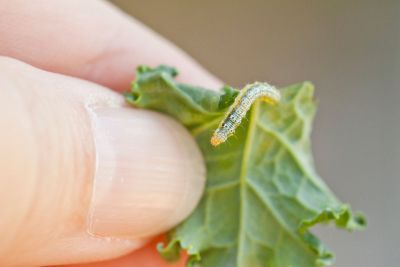Most Common Cabbageworm Pests
The Imported cabbageworm (the larval form of the Cabbage White butterfly having white wings with one or two black spots per wing) is velvety green with a narrow, light yellow stripe down the middle of its back. These worms tend to feed closer to the center of the plant. Cross-Striped cabbageworms are bluish gray with numerous black stripes running cross-wise. A black and yellow stripe also runs along the length of the body. Larvae feed on all tender parts of the plant, but prefer buds. Young leaves and buds are often riddled with holes. Also, watch for cabbage loopers on the undersides of lower leaves, examining them for newly hatched larvae. Check around the base of the head for larger worms. They will be light green with a pale white stripe down each side and two thin white stripes down the back. In addition, the worms move in a looping motion, as they have no middle legs. The larvae of Diamondback moths can be destructive too. Eggs are found on the undersides of lower leaves and the larvae are small, yellowish green, with a forked tail. While they feed on all plant parts, they usually prefer the buds of young plants. Look for young larvae emerging from small holes in the underside of the leaf. Older larvae create a more skeletonized look to the leaves.
Cabbageworm Control
While successful control of cabbageworms depends on proper identification, timing of applications and suitable insecticide coverage, most are treated much the same. Start checking for cabbageworms in early spring or as soon as you see adult cabbageworm butterflies or cabbage moths flying around the garden. You can also install floating row covers over crops to prevent adult moths/butterflies from laying eggs on plants. Check crops weekly for these pests and their feeding damage, examining both sides of leaves. The best time to treat is while the larvae are still small, as older worms tend to cause the most damage. Insecticides may not be as effective in killing older cabbageworms, however, handpicking (especially in smaller gardens) is effective, dropping them into a pail of soapy water. While it is possible to use broad spectrum pesticides, such as permethrin, these insecticides will also kill natural enemies that are present in the garden. The use of Bacillius thuringiensis (Bt), a non-toxic, biological insecticide, is effective and is specifically targeted towards worms/caterpillars. It’s also safe and can be used on most garden vegetables. Using Bt will not harm any beneficial insects, including natural enemies of these worms. Another alternative is neem oil. It’s also safe to use, effective against many pests (including caterpillars), and will not affect beneficial insects.
Additional Organic Control for Cabbage Moths
It is believed that growing cabbage with red or white clover results in fewer cabbage white butterflies and moths in part to camouflage and predators. Cabbage moth caterpillars can also be averted by surrounding beds with strongly perfumed herbs, like lavender, or interplanting with other crops. Most moths and butterflies find food sources using scents and silhouettes, therefore, disguising cabbage plants may offer more protection. Crushed eggshells scattered around the base of your plants may also deter the butterflies from laying their eggs.
